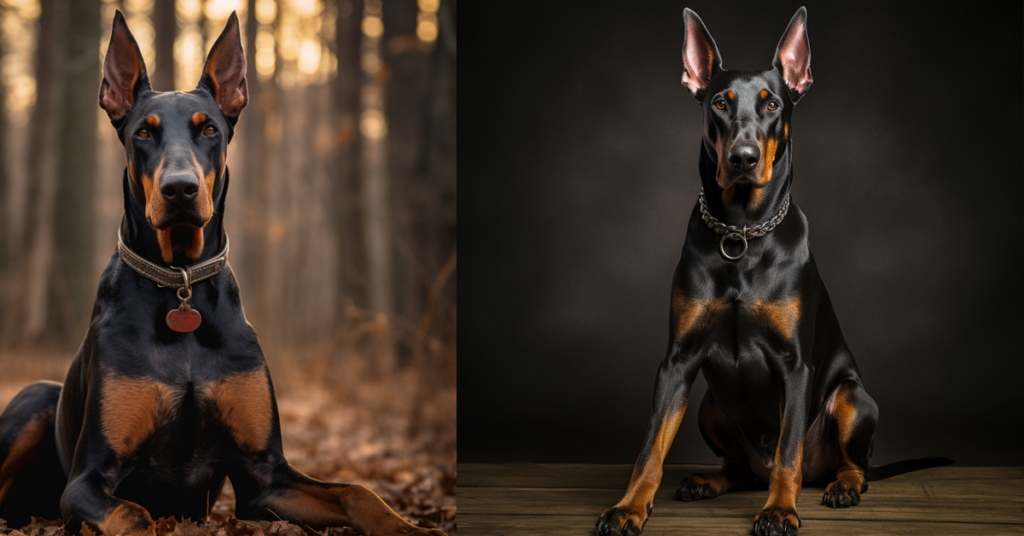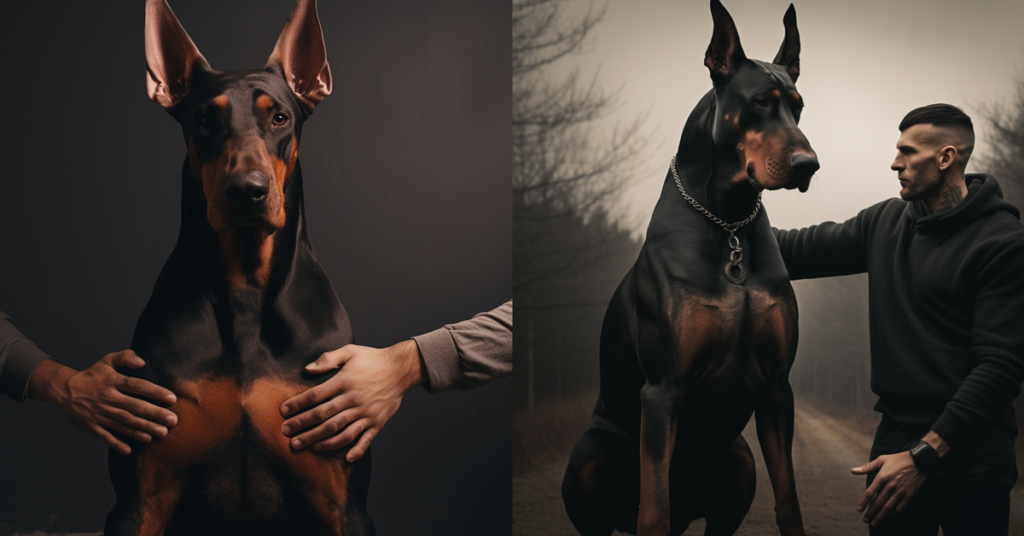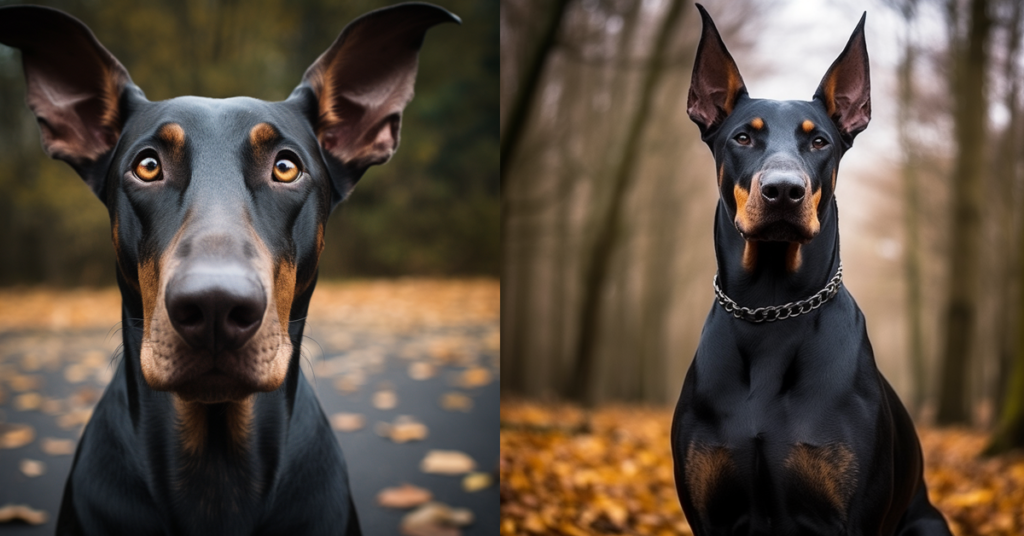When bringing home a Doberman puppy, it’s natural to wonder when they will reach their full size and physical maturity. Understanding the growth stages of a Doberman is essential for providing appropriate care and meeting their unique needs at different life stages. In this blog post, we will explore the timeline and factors that contribute to a Doberman’s growth, helping you gain insights into when your furry companion will be fully grown.
Importance of understanding the growth stages of a Doberman
Understanding the growth stages of a Doberman is crucial for several reasons. Firstly, it allows you to adjust their diet, exercise routine, and overall care to support healthy growth and development. Secondly, knowing when a Doberman is fully grown helps manage expectations in terms of their size, energy levels, and exercise requirements. Lastly, being aware of the growth stages enables you to recognize signs of potential health issues or abnormalities early on, ensuring prompt veterinary attention if needed.
By delving into the growth journey of Doberman Pinschers, you’ll gain valuable insights into how to best nurture and care for your beloved companion at each stage of their development. Let’s dive in!

Growth Stages of a Doberman
Puppyhood
Puppyhood is an exciting and crucial stage in a Doberman’s growth journey. During this period, they experience significant developmental milestones and undergo noticeable physical changes. In the first few months, Doberman puppies grow rapidly, both in size and abilities.
At around 2 to 3 weeks old, their eyes and ears begin to open, allowing them to explore the world around them. They start taking their first wobbly steps, gradually gaining coordination and mobility. By the end of the third month, most Doberman puppies have developed their primary set of teeth, enabling them to chew on solid food.
During puppyhood, Dobermans also go through teething, which can be a challenging phase for both the puppy and their owners. It’s essential to provide appropriate chew toys and supervise their chewing habits to prevent destructive behavior.
Adolescence:
As Doberman puppies transition into adolescence, typically between 6 months to 1 year of age, they enter a phase known for significant changes in behavior and size. This period is characterized by increased energy levels, curiosity, and a strong desire to explore their surroundings.
Physically, Dobermans experience a growth spurt during adolescence, where they may appear lanky or awkward as their body adjusts to their eventual adult size. It’s important to provide regular exercise and mental stimulation during this phase to support proper muscle development and maintain a healthy weight.
Behaviorally, Doberman adolescents may exhibit some challenging traits, such as increased independence, testing boundaries, and occasional stubbornness. Consistent training and positive reinforcement are vital to guide them through this phase and establish good manners and behavior.
Young Adult:
A Doberman is generally considered a young adult between 1 to 2 years of age. By this stage, they have reached their full height, although they may continue to fill out and gain muscle mass until around 3 years old.
Physically, a young adult Doberman exhibits a well-defined muscular body with a sleek coat. They have achieved their adult size and weight, providing a more stable frame compared to their adolescent phase.
Mentally, young adult Dobermans are more emotionally mature and tend to have a better grasp of training commands and expectations. Their energy levels may still be high, requiring regular exercise and mental stimulation to keep them engaged and content.
Understanding the growth stages from puppyhood to young adulthood enables you to provide the appropriate care, training, and socialization necessary for your Doberman’s development. Each stage brings unique challenges and rewards, paving the way for a strong and healthy bond with your furry friend.

Factors Affecting Growth Rate
Genetics:
Genetics play a significant role in determining the growth rate and overall size of a Doberman. The genes inherited from their parents influence their potential height, weight, bone structure, and other physical characteristics. Responsible breeders carefully select breeding pairs to ensure desirable traits are passed down to the offspring.
It’s important to note that while genetics provide a blueprint, environmental factors and proper care also play a crucial role in a Doberman’s growth and development. Genetics set the foundation, but it’s up to owners to provide the necessary conditions for optimal growth.
Nutrition:
Proper nutrition is vital for the healthy growth and development of a Doberman. A balanced diet, tailored to their specific life stage, ensures they receive the essential nutrients needed for bone development, muscle growth, and overall well-being.
During the puppyhood stage, Doberman puppies require a diet rich in high-quality protein, healthy fats, and a balance of vitamins and minerals. This helps support their rapid growth and provides them with the energy they need for their active lifestyle.
As Dobermans transition into adulthood, their nutritional needs change. A well-balanced diet that includes lean protein sources, complex carbohydrates, and healthy fats helps maintain their ideal weight, supports healthy muscle development, and promotes overall longevity.
Consulting with a veterinarian or canine nutritionist can help determine the appropriate diet for your Doberman at each life stage and address any specific dietary requirements or sensitivities.
Exercise and Physical Activity:
Regular exercise and physical activity play a vital role in a Doberman’s growth rate and muscle development. Exercise helps stimulate their muscles, promote bone health, and maintain a healthy weight.
However, it’s important to strike a balance when it comes to exercise, particularly during the puppyhood and adolescence stages. Too much high-impact exercise or excessive jumping can put strain on their developing joints and bones. On the other hand, inadequate exercise can lead to weight gain, muscle weakness, and behavioral issues.
Providing appropriate exercise for your Doberman means considering their age, current physical condition, and breed-specific needs. Regular walks, controlled play sessions, and mental stimulation activities such as puzzle toys or training exercises can help meet their exercise requirements while avoiding overexertion.
It’s worth noting that as Dobermans reach young adulthood, their exercise needs may increase. Engaging them in activities like agility training, obedience training, or even participating in dog sports can further enhance their muscle development and overall fitness.
By providing a balanced approach to exercise and physical activity, taking into account their growth stage and individual needs, you can support optimal growth, muscle development, and overall well-being for your Doberman.

Signs of Full Maturity
Physical Appearance:
One of the telltale signs that a Doberman has reached full maturity is the closure of their growth plates. Growth plates are areas of cartilage located at the ends of the long bones in puppies. As they mature, these growth plates gradually close, indicating the end of their physical growth.
Typically, the growth plates in Dobermans close around 12 to 18 months of age, although it can vary between individuals. Once the growth plates are closed, the bones can no longer lengthen, and the Doberman’s height and size stabilize.
At full maturity, a Doberman typically stands at a height of around 24 to 28 inches at the shoulder, with males generally being larger than females. Their weight ranges from 65 to 90 pounds, depending on factors such as genetics, diet, and exercise.
Other physical characteristics that indicate full maturity include a well-developed musculature, a sleek and glossy coat, and a strong overall physique. It’s important to note that individual variations may occur, and some Dobermans may take a little longer to reach their full size and physical maturity.
Behavior and Temperament:
As Dobermans reach full maturity, their behavior and temperament may undergo some changes. Generally, they become more emotionally stable, and their energy levels tend to decrease slightly compared to their adolescent phase.
Dobermans at full maturity are known for their loyalty, intelligence, and protective nature. They have a strong desire to please their owners and can be easily trained. With proper socialization and training from an early age, they often exhibit well-mannered and confident behavior.
While their playful and active nature may persist, Dobermans tend to become more composed and less prone to impulsivity as they mature. They have a better understanding of boundaries and rules, making them easier to manage in various situations.
Additionally, full-grown Dobermans often demonstrate a heightened sense of alertness and make excellent watchdogs. Their protective instincts are more pronounced, and they are inherently wired to guard and protect their families.
It’s important to remember that individual temperament can vary among Dobermans, even within the same litter. Early socialization, consistent training, and providing mental stimulation continue to play a crucial role in shaping their behavior and ensuring a well-rounded and balanced adult Doberman.
By being aware of the physical and behavioral changes that occur as a Doberman reaches full maturity, you can better understand and appreciate the unique characteristics of your beloved companion. Embracing their growth journey and providing the care and attention they need will foster a strong and fulfilling bond with your Doberman.
Timeframe for Full Growth
The timeframe for a Doberman to reach full growth and maturity can vary between individuals. However, there are general guidelines that can give you an idea of when a Doberman is considered fully grown.
For both male and female Dobermans, the typical timeframe for reaching full physical maturity is between 18 months to 2 years of age. During this period, they go through important developmental stages, including the closure of growth plates and the stabilization of their size.
It’s important to note that while most Dobermans reach their full height and weight by around 2 years old, some may continue to fill out and gain muscle mass until they are around 3 years old. This gradual filling out contributes to their overall physique and strength.
The importance of monitoring physical and behavioral changes
It’s crucial to remember that individual variations exist among Dobermans, just as they do among humans. Some Dobermans may reach full maturity earlier or later than the general timeline mentioned above.
Monitoring your Doberman’s physical and behavioral changes is key to understanding their growth progress. Keep an eye on their height, weight, muscle development, and overall appearance. If you have any concerns about their growth rate or development, it’s always best to consult with a veterinarian who can provide personalized advice based on your specific dog’s needs.
In addition to physical changes, pay attention to any shifts in their behavior and temperament as they mature. While most Dobermans become more emotionally stable and well-behaved as they reach full maturity, some individuals may exhibit unique characteristics or show variations in their development. Each Doberman is an individual with their own personality, and it’s essential to embrace and appreciate their unique traits.
By closely monitoring your Doberman’s physical and behavioral changes, you can ensure their overall well-being and address any concerns that may arise along their growth journey. Remember, providing regular veterinary care, a balanced diet, adequate exercise, and mental stimulation will contribute to their healthy growth and development.
Care Tips for a Growing Doberman
Appropriate diet and feeding practices to support healthy growth
Providing a proper diet is essential for the healthy growth and development of a Doberman. Here are some tips to ensure they receive the nutrition they need:
- Choose a high-quality dog food specifically formulated for large breed puppies. Look for a well-balanced diet that includes lean proteins, complex carbohydrates, and healthy fats.
- Follow the recommended feeding guidelines provided by the food manufacturer. Adjust the portion sizes as needed based on your individual Doberman’s growth and activity level.
- Divide their daily meals into two or three smaller meals to aid digestion and prevent bloating, which is a common concern in deep-chested breeds like Dobermans.
- Avoid overfeeding or free-feeding, as this can lead to excessive weight gain and potential health issues. Monitor their body condition and adjust the portions accordingly.
Consulting with a veterinarian or canine nutritionist can provide further guidance on the best diet and feeding practices for your growing Doberman.
Importance of regular veterinary check-ups and vaccinations during the growth stages
Regular veterinary check-ups and vaccinations are crucial for ensuring the overall health and well-being of your growing Doberman. Here’s why they are important:
- Veterinary check-ups allow early detection of any health concerns or developmental issues. Regular examinations help monitor their growth progress, address any concerns, and ensure they are on track for a healthy adulthood.
- Vaccinations protect your Doberman from various diseases and illnesses that can be potentially life-threatening. Following the recommended vaccination schedule ensures they have optimal immunity and protection against common canine diseases.
- Routine preventive care, such as dental cleanings and parasite control, helps maintain their overall health and prevents common issues like dental disease and flea infestations.
Work closely with your veterinarian to establish a vaccination schedule and determine the appropriate timing for check-ups based on your Doberman’s individual needs.
Recommendations for exercise and mental stimulation to promote proper muscle development and mental well-being
Exercise and mental stimulation are vital for a growing Doberman’s physical and mental well-being. Consider the following recommendations:
- Provide regular exercise tailored to their age and physical condition. Daily walks, interactive play sessions, and off-leash activities in a secure environment help burn off excess energy and promote muscle development.
- Engage them in activities that challenge their mind, such as puzzle toys, obedience training, or agility exercises. Mental stimulation helps prevent boredom and keeps their minds sharp.
- Avoid excessive high-impact exercise during their growth stages to protect their developing joints and bones. Instead, focus on controlled and structured activities that promote proper muscle development without causing strain.
- Gradually increase the intensity and duration of exercise as they mature. This gradual progression allows their bodies to adapt and build strength over time.
Remember to always consider your Doberman’s individual needs, energy level, and any specific health concerns when planning their exercise routine.
By following these care tips, you can ensure that your growing Doberman receives the nutrition, veterinary care, and exercise they need for healthy growth and development. Remember, each Doberman is unique, so monitor their progress and consult with professionals for personalized guidance along the way.
Conclusion
In this blog post, we explored the various aspects of a Doberman’s growth stages and provided valuable information to help understand their development. Here’s a recap of the key points:
- Signs of Full Maturity: We discussed the physical characteristics that indicate a Doberman has reached full maturity, such as the closure of growth plates and stable size.
- Behavior and Temperament: We explored how a Doberman’s behavior and temperament may change as they reach maturity, emphasizing their loyalty, intelligence, and protective nature.
- Timeframe for Full Growth: We provided a general timeline for when a Doberman is considered fully grown, acknowledging individual variations and the importance of monitoring physical and behavioral changes.
- Care Tips for a Growing Doberman: We offered guidance on appropriate diet and feeding practices, highlighted the significance of regular veterinary check-ups and vaccinations, and provided recommendations for exercise and mental stimulation.
Importance of understanding a Doberman’s growth stages for their overall well-being and development
Understanding a Doberman’s growth stages is crucial for their overall well-being and development. By being aware of the physical and behavioral changes that occur as they mature, you can provide appropriate care and support their growth journey. This knowledge enables you to make informed decisions regarding their diet, exercise routine, and healthcare needs, ensuring they thrive both physically and mentally.
Monitor their Doberman’s growth and seek professional advice when needed
As responsible dog owners, it’s essential to closely monitor our Dobermans’ growth and be attentive to any changes or concerns. Regularly assess their physical appearance, behavior, and overall health. If you notice anything unusual or have questions regarding their growth progress, don’t hesitate to seek professional advice from a veterinarian or other canine experts. They can provide personalized guidance and address any specific needs your Doberman may have.
By actively monitoring and seeking professional advice when needed, you can ensure that your Doberman receives the care and support necessary for healthy growth and development. Remember, a well-informed and attentive approach is key to nurturing a happy and thriving Doberman companion.
